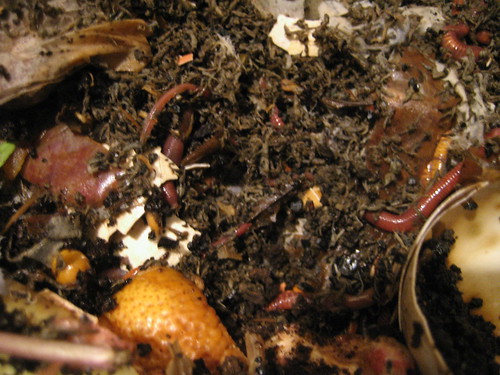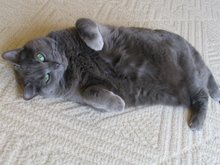One of my favorite Christmas gifts this year (other than this, of course) is a book called "The Urban Homestead: Your Guide to Self-Sufficient Living in the Heart of the City" by Kelly Coyne and Erik Knutzen, writers of the blog Homegrown Evolution. It's an incredible primer on all things livegreen in the city, full of instructions on how to make things like self-watering plant containers that you can use to grow veggies on your fire escape. I used their instructions to make a new and improved worm bin for my basement ( I had to leave this old one behind in Davis). The new one is a double layered system that will make harvesting the compost a lot easier (it involves drilling holes in the tupperware to allow the worms to migrate between bins, tee hee!).

To get my worms I sent out a request on the American Community Gardening Association listserve and Dorene in Phoenixville let me come harvest about two pounds of red wigglers from her worm bin to start mine.

I also started an outdoor compost bin for yard scraps and veggie scraps. I don't have enough land to repeat the one I made in Davis so I just got a plastic garbage bin, drilled some holes for air flow and stuck it on my patio.

The worms can't handle the amount of compost we produce in the house (which as you can see is mostly egg shells and coffee grounds right now), so it's neccessary to have the other compost bin to handle the excess. It will take longer than the worm bin to become usable compost, but I can wait.

Other parts of the book that I love include the section on how to harvest and eat "feral edibles," weed veggies like dandelion leaves, nasturtium pods, sheep sorrel, and purslane, the section on how to make your own solar food dryer, and the section on raising chickens in the city (have I mentioned that I want some?). The attitude of the authors is that anyone can do these things, you don't need to have a lot of money or land. You can grow lettuce in a tub in your living room. You can brew beer in your basement. You can harvest greens for dinner from a vacant lot. The attitude is very "can-do" and inspiring. You will be reading more about this book here in the future, you can bet your sweet patoot.

To get my worms I sent out a request on the American Community Gardening Association listserve and Dorene in Phoenixville let me come harvest about two pounds of red wigglers from her worm bin to start mine.

I also started an outdoor compost bin for yard scraps and veggie scraps. I don't have enough land to repeat the one I made in Davis so I just got a plastic garbage bin, drilled some holes for air flow and stuck it on my patio.

The worms can't handle the amount of compost we produce in the house (which as you can see is mostly egg shells and coffee grounds right now), so it's neccessary to have the other compost bin to handle the excess. It will take longer than the worm bin to become usable compost, but I can wait.

Other parts of the book that I love include the section on how to harvest and eat "feral edibles," weed veggies like dandelion leaves, nasturtium pods, sheep sorrel, and purslane, the section on how to make your own solar food dryer, and the section on raising chickens in the city (have I mentioned that I want some?). The attitude of the authors is that anyone can do these things, you don't need to have a lot of money or land. You can grow lettuce in a tub in your living room. You can brew beer in your basement. You can harvest greens for dinner from a vacant lot. The attitude is very "can-do" and inspiring. You will be reading more about this book here in the future, you can bet your sweet patoot.




No comments:
Post a Comment